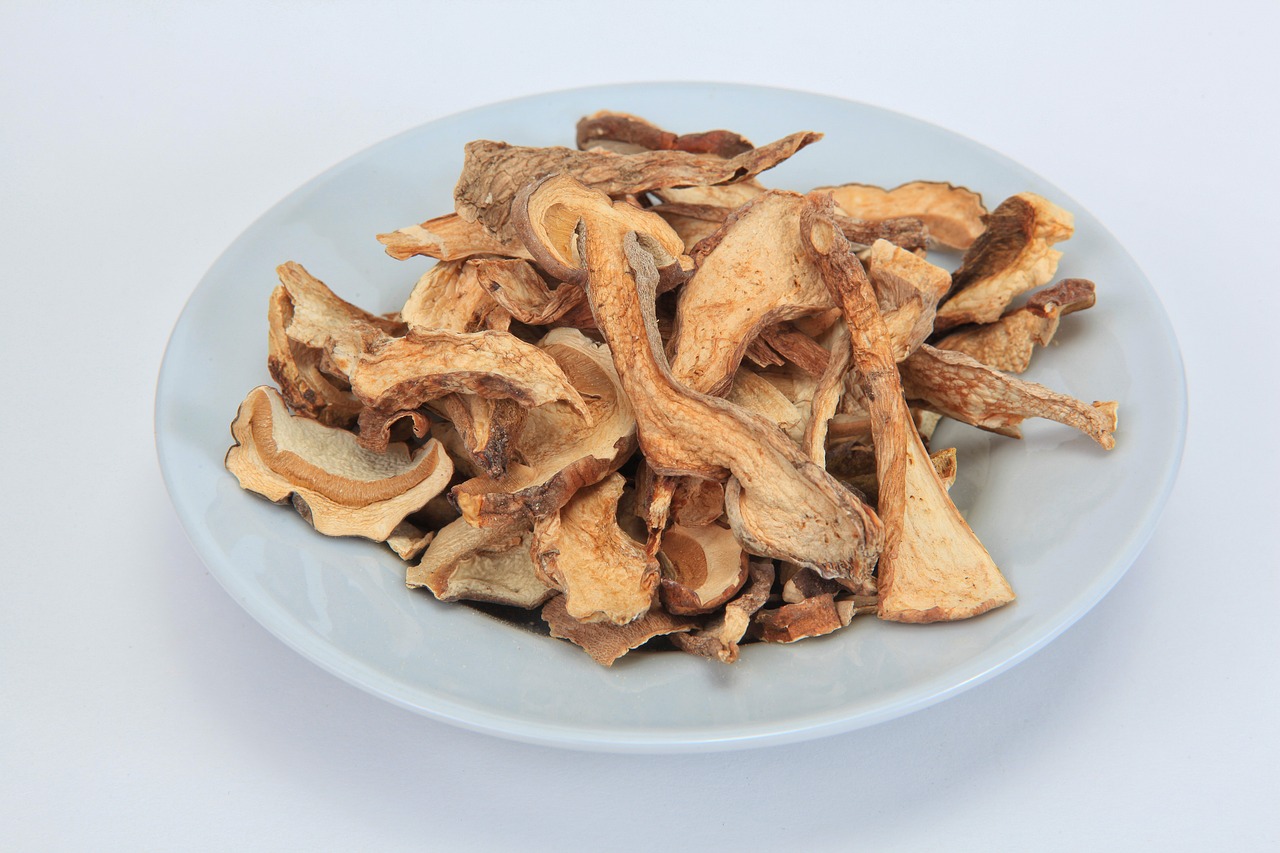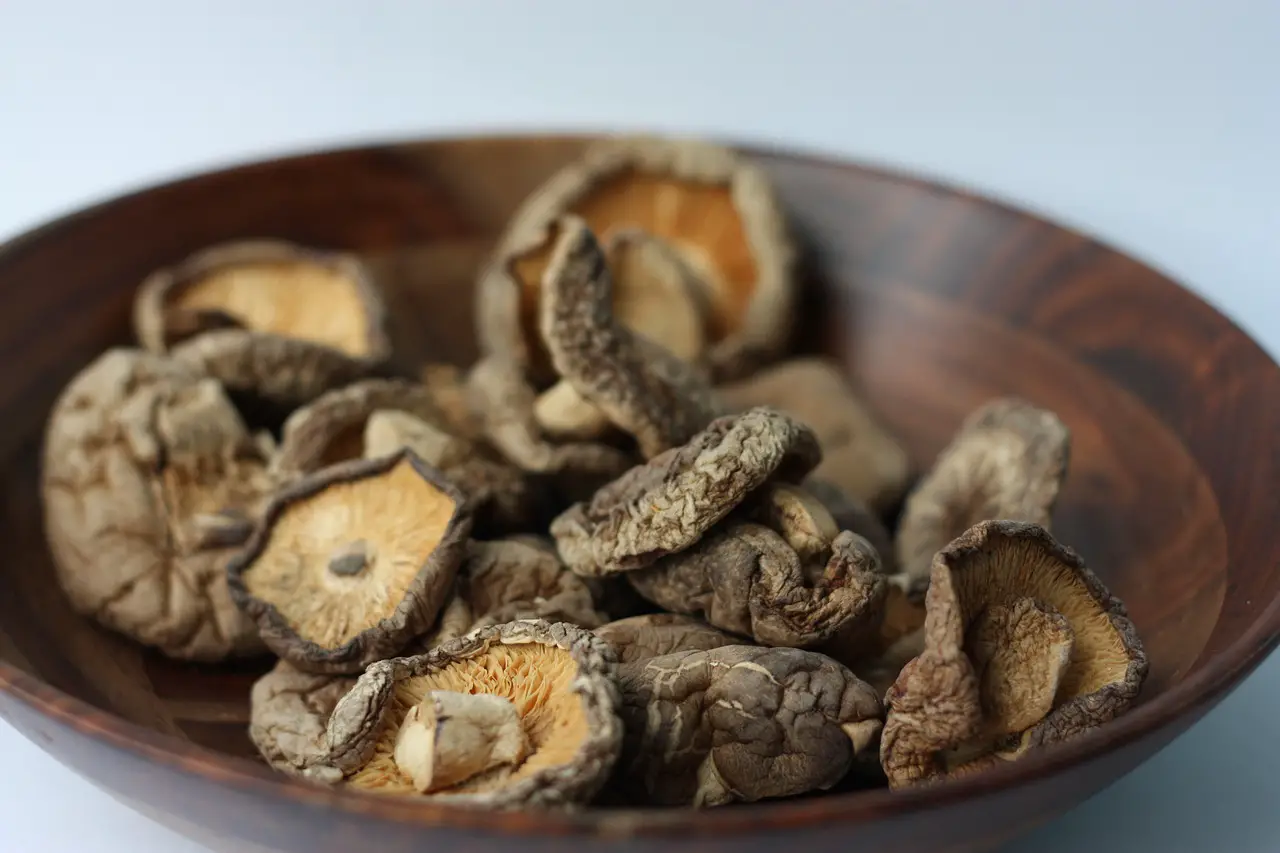After your mushrooms have dried, you can put them in the freezer or the refrigerator. Both options have the same texture and flavour. They can also be kept at room temperature, although it’s better to do so in a place with low humidity to avoid mould growth, away from fresh vegetables or spices that can absorb moisture, and stored in an airtight container.

You can easily add an earthy flavour to soups, stews, spaghetti, stir-fries, omelettes, and various other foods by using dried mushrooms in your cooking. In your kitchen, a few dried mushrooms can go a long way; if they are stored properly, they can last for a long time.
What are Dried Mushrooms?
A type of fungi that has been preserved, frequently with the aid of heat, is dried mushrooms. Although there are numerous ways to dry them (sun, freeze), industrial technology is used in most commercial manufacturing to dehydrate them at low temperatures for extended periods.
The outcome is an edible product with more nutrients per serving than fresh mushrooms. Before usage, industrially dehydrated mushrooms are frequently rehydrated by soaking in water. They are simple to reconstitute, but the texture differs from fresh mushrooms—like a meaty vegetable.
Additionally, the flavour and nutritional content won’t be as good as the original raw form. These mushrooms are typically used in stews or soups. Shiitakes, porcinis, and oysters are a few of the more well-liked varieties of dried mushrooms.
Try including them in your diet if you want to go to a vegan lifestyle since they can serve as meat alternatives. However, some varieties, like the flat white variety, don’t have much flavour on their own, so it’s recommended to cook them with other savoury ingredients first, like powdered soybean flour, to ensure that they sufficiently soak up the flavours before serving.
Reference: Analysis of the flavor of the dried mushroom, Boletus edulis
How to Store Dried Mushrooms?
Could you keep it in a cool, dry place? Dried mushrooms can be stored for several years if kept dry and out of direct sunlight. After opening the original bag, store the remaining contents in a tightly sealed container, such as a glass or plastic jar with a tight-fitting lid. If you intend to keep the dried mushrooms for more than six months, store them in a hard container in your freezer.
Storing in the Refrigerator or Freezer
Select an airtight container. The best storage containers for dried mushrooms are glass canning jars and plastic resealable bags (such as Mason jars). The glass jars ought to have screw-on lids that fit snugly.
- Make sure you use freezer-specific plastic bags if you’re using resealable bags rather than thinner sandwich bags.
- Mason jars are secure for freezer storage since dried mushrooms will not be expanding in the freezer (as liquids will do).
Put the date on your container’s label. For up to 12 months, dried mushrooms can be stored in the freezer or refrigerator. It may be simple to overlook how long dried mushrooms have been in the freezer if you don’t use them frequently.
Put the dried mushrooms in new packaging. Pour the dry mushrooms from their original packet into the airtight container after you’ve labelled it. Squeeze out as much air as you can from a plastic bag before sealing it if you’re using one that can be resealed.
- There is no immediate need to repackage dried mushrooms that you purchased in a vacuum-packed, sealed bag and are not going to use immediately. But after using some of the mushrooms from the package, close the packaging again and store the remaining mushrooms in an airtight container.
Put the repackaged mushrooms in the freezer or refrigerator. The dried mushrooms might still be edible even if you observe freezer burn on them, but their texture might change to something rubbery. Avoid placing heavy objects on top of freezer bags with dried mushrooms to prevent crushing.
Storing at Room Temperature
Select an airtight container. Plastic resealable bags and glass canning jars are ideal storage containers for dried mushrooms (such as Mason jars). The glass jars should have screw-on lids that fit snugly.
Put the dried mushrooms in new packaging. Pour the dry mushrooms from their original packet into the airtight container after you’ve labelled it. Squeeze out as much air as you can from a plastic bag before sealing it if you’re using one that can be resealed.
- There is no immediate need to repackage dried mushrooms that you purchased in a vacuum-packed, sealed bag and are not going to use immediately. Finding an airtight container for the leftover mushrooms is a good idea once you open the package and use some of the mushrooms.
- You can think about putting oxygen-absorbing packets in your resealable bags or jars if you reside in a humid area. These packets contain iron powder, which absorbs most oxygen from their container and can delay food deterioration for a longer time. Although they are not strictly necessary, oxygen absorption packets are a good idea when storing mushrooms, especially if you keep them at room temperature in a kitchen cabinet.
Dried mushrooms are extremely sensitive to light and moisture, like their fully hydrated cousins. The back of a storage cabinet is the ideal place to keep dried mushrooms since there; they are less likely to be exposed to light. The dried mushrooms should be put in the cabinet’s rear.
Storing in Glass Jars
It is critical to keep dried mushrooms in airtight containers when storing them. A glass jar with a tight-fitting lid is the best option. Plastic resealable bags work well, but make sure they are completely airtight before sealing.
Mushrooms will develop sliminess and become slimy if not exposed to fresh air. A glass jar can help keep excess moisture away from the mushrooms, which can cause them to shrink or wrinkle. Fresh mushrooms quickly lose moisture, so store them in breathable packaging to allow air to circulate and avoid draughts. Furthermore, washing mushrooms before storing them can shorten their shelf life.
Dried mushrooms should be stored in airtight jars to prevent mould from growing due to moisture. They should be kept cool and dry, away from direct sunlight. They will keep their flavour for up to six months if properly stored. They can be rehydrated after drying by soaking them in boiling water. This liquid can then be used to make soup bases or sauces.
Air-Drying
Cut off the dried mushroom’s substrate, or the layer of material that the mycelium uses to grow, before letting it air dry. The mushrooms are ready to be dried once this layer has been removed. Place a desiccant pack and a vacuum-sealed bag with the mushrooms inside. Keep the bag in a room that’s cool and dark. A mason jar or Tupperware container are also options.
Understanding how to string the mushrooms correctly is crucial before beginning the air-drying process. While preserving the flavour of the mushrooms, a thin slicing technique helps hasten the drying process. The mushrooms should be laid out in a single layer to ensure drying.
Thread Drying
Although there are various ways to store mushrooms, thread drying is one of the most straightforward and affordable. Unlike most other methods, it doesn’t use gas or electricity and can maintain the flavour of mushrooms better. You can do this operation either inside or outside. A sterile needle and thread are all that is required.
Initially, check to see if the mushrooms are clean. Take out any insects or other little debris. After that, space them two inches apart with a thick cotton thread. Hang them up somewhere cool and dark. The mushrooms will need several days to dry. When they are completely dry, you can keep them in jars or other storage options to maintain their quality.
How Long will Dried Mushrooms Keep?
If you are not accustomed to eating fresh mushrooms, you might wonder how long dried mushrooms last.
Dried mushrooms can normally be stored in an airtight container for a year or two. Dried mushrooms won’t keep for very long if they are exposed to the air, just like fresh mushrooms.
If you want the full flavour of your mushrooms when you use them, you must store them in airtight containers or vacuum-sealed bags since they can lose flavour and become less delicate over time.
It is preferable to store them in a cold, dark area like a pantry to maintain them at their best. Mushrooms can be freeze-dried and stored for up to a year, but you should be aware of how much moisture is lost during the freezing process as it could impair flavour or texture.
Even if your recipe asks for fresh mushrooms, using some dried ones may improve the dish’s flavour without significantly altering the nutritional value.
Why Not Use Fresh Mushrooms Instead of Dried?
When you remove the water from fresh mushrooms, you are left with a highly concentrated product packed with flavour and nutrients. Dried mushrooms retain all their medicinal and immune-boosting properties, unlike vegetables, which lose much of their nutritional value when processed.
How do You Know If Dried Mushrooms are Bad?
Nobody likes wasting food, especially when it is expensive. Dried mushrooms are costly and can be difficult to obtain at times. They appear to be an investment worth preserving with a dropper in the bag, but how do you know if dried mushrooms go bad?
You could try smelling them before eating or cooking with them. This method, however, does not always work because there may be no odour associated with spoiling products.
The colour change from dark brown/black to light can sometimes be used to identify bad mushrooms.
Two other methods are checking for mould or determining whether they have faded and become dry and brittle. It’s also worth noting that due to their low water content, dried mushrooms may take longer to spoil than fresh ones.
You can also examine the texture.
Dried mushrooms should be firm, elastic, and leathery in texture rather than brittle or hard.
If you are unsure whether they have gone bad, it is best to throw them away just in case.
Regarding food safety, it’s always better to err on the side of caution.
Conclusion
Dried mushrooms are an excellent way to enhance the flavour and texture of any dish. They can be used in soups, stews, stir-fries, or appetisers. Drying the fungi is also a good way to store them for future use, reducing the likelihood that they will spoil before you use them again.
Dried mushrooms typically have a shelf life of 10 months to a year, depending on how long they have been stored and the type of mushroom harvested. It is critical to ensure that your product is fresh and to know when it expires so you do not waste anything.
